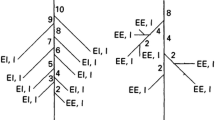Abstract
In models of oxygen, water and nutrient uptake by plant roots, the degree of root-soil contact is an important parameter. An observation technique is required to evaluate to what extent root-soil contact depends on plant species, soil texture and structure. Thin sections for studying soil structure may be used for this purpose, provided that roots do not shrink during section preparation, and that all root cross sections are recognized.
Maize was grown in pots with soil aggregates obtained by sieving and compacting to three bulk densities. Thin sections were made by freeze-drying samples before impregnating the soil with resin. Two checks were made on the validity of the method. Firstly, visual appearance of roots with intact epidermis, cortex and other tissues did not show signs of shrinkage. Secondly, the agreement was checked between root lengths obtained by washing duplicate soil samples and the number of root cross sections counted on horizonal and vertical thin sections. For the latter, the angle at which roots intersected the thin-section plane was determined from the shape of the cross sections. The frequency distribution of calculated angles was in agreement with the frequency distribution expected for a randomly oriented set of cylinders when an error term was included in the simulated measurements.
Some results are presented for a field test of the thin-section method with barley on a calcareous marine sandy loam. Root hairs, apparently undamaged by sample preparation, are important for bridging the gap between roots and soil in this situation. According to the experience presented, the thin-section technique is suitable to derive the degree of root-soil contact, as influenced by species, soil texture and structure, in samples obtained from pot or field experiments.
Similar content being viewed by others

References
Altemüller H-J and Haag Th 1983 Mikroskopische Untersuchungen an Maiswurzeln im ungestörten Bodenverband. Kali-Briefe (Büntehof) 16, 349–363.
Atemüller H-J and Vorbach A 1987 Veränderungen des Bodengefüges durch Wurzelwachstum von Maispflanzen. Mitt. Deutschen Bodenkundlichen Gesellschaft 55, 93–98.
Boone F R 1988 Weather and other environmental factors influencing crop responses to tillage and traffic. Soil Tillage Res. 11, 283–324.
Boone F R and Veen B W 1982 The influence of mechanical resistance and phosphate supply on morphology and function of maize roots. Neth. J. Agric. Sci. 30, 179–192.
DeWilligen P and VanNoordwijk M 1984 Mathematical models on diffusion of oxygen to and within plant roots, with special emphasis on effects of soil root contact: I. Derivation of the models. II. Applications. Plant and Soil 77, 215–241.
De Willigen P and Van Noordwijk M 1987 Roots, Plant Production and Nutrient Use Efficiency. Doctoral Thesis, Wageningen Agricultural University, 282 p.
Eriksson J, Hoakansson I and Danfors B 1974 The effect of soil compaction on soil structure and crop yields. Swed. Inst. Agric. Eng., Bull. no. 354, 101 p.
Ismail S N A 1975 Micromorphometric soil-porosity characterization by means of electro-optical image analysis (Quantimet 720). Soil Survey Papers no. 9, Netherlands Soil Survey Institute, Wageningen, 104 p.
Jongerius A and Heintzberger G 1975 Methods in soil micromorphology: A technique for the preparation of large thin sections. Soil Survey Papers no. 10, Netherlands Soil Survey Institute, Wageningen, 48 p.
Kendall M G and Moran P A P 1963 Geometrical Probability. Charles Griffin, London, 125 p.
Kooistra M J 1979 Two methods of preparing thin sections of wet soil from sediments in a marine intertidal zone in the Oosterschelde (The Netherlands). Neth. J. Agric. Sci. 27, 235–240.
Kooistra M J, Lebbink G and Brussaard L 1989 The Dutch programme on soil ecology of arable farming systems. 2. Geogenesis, agricultural history, field site characteristics and present farming systems at the Lovinkhoeve experimental farm. Agric. Ecosyst. Environm. 27, 361–387.
Miedema R, Pape T and Van derWaal G J 1974 A method to impregnate wet soil samples, producing high quality thin sections. Neth. J. Agric. Sci. 22, 37–39.
Soane B D 1985 Traction and transport systems as related to cropping systems. pp 863–895. Proc. Int. Conf. on Soil Dynamics, 17–19 June 1985, Auburn, AL, USA.
Tippkötter R, Ritz K and Darbyshire J F 1986 The preparation of soil thin sections for biological studies. J. Soil Sci. 37, 681–690.
VanNoordwijk M, Floris J and DeJager A 1985 Sampling schemes for estimating root density distribution in cropped fields. Neth. J. Agric. Sci. 33, 241–262.
Van Noordwijk M 1987 Methods for quantification of root distribution pattern and root dynamics in the field, pp 263–281. 20th Colloq. Intern. Potash Inst., Baden bei Wien, Austria.
Author information
Authors and Affiliations
Additional information
Communication No. 43 of the Dutch Programme on Soil Ecology of Arable Farming Systems.
Communication No. 43 of the Dutch Programme on Soil Ecology of Arable Farming Systems.
Rights and permissions
About this article
Cite this article
Van Noordwijk, M., Kooistra, M.J., Boone, F.R. et al. Root-soil contact of maize, as measured by a thin-section technique. Plant Soil 139, 109–118 (1992). https://doi.org/10.1007/BF00012848
Received:
Issue Date:
DOI: https://doi.org/10.1007/BF00012848



